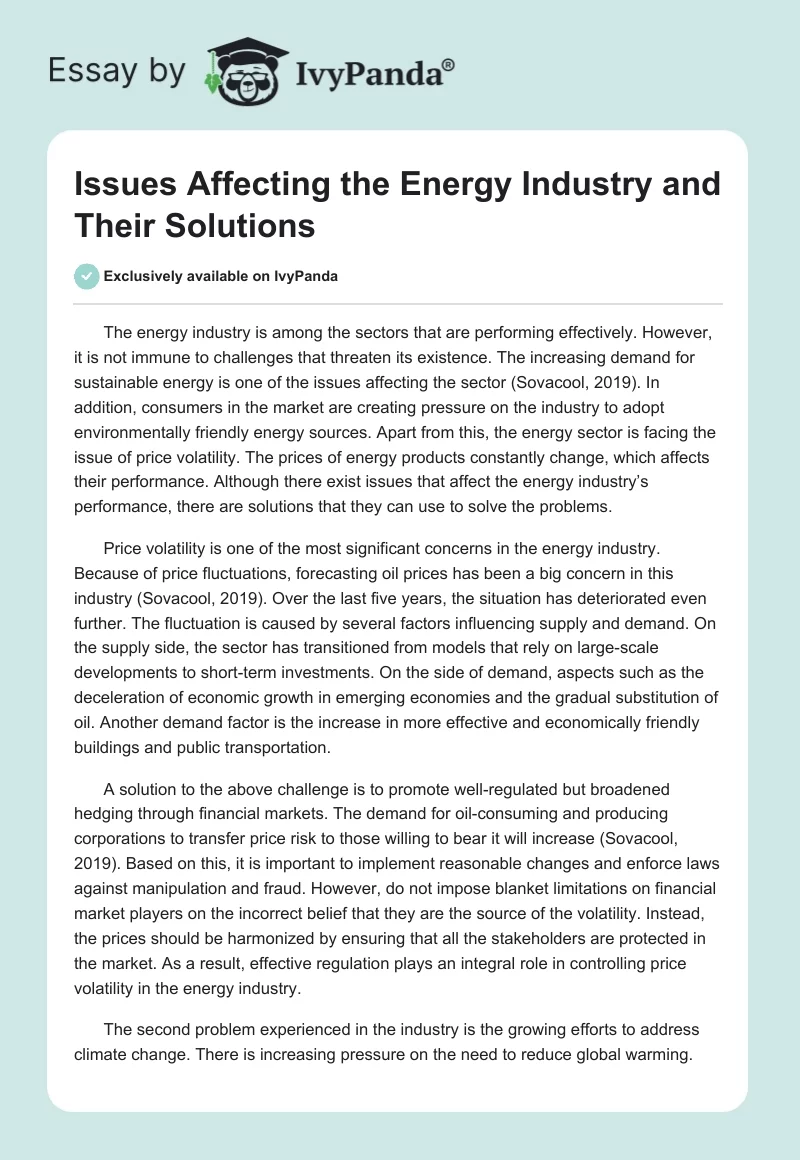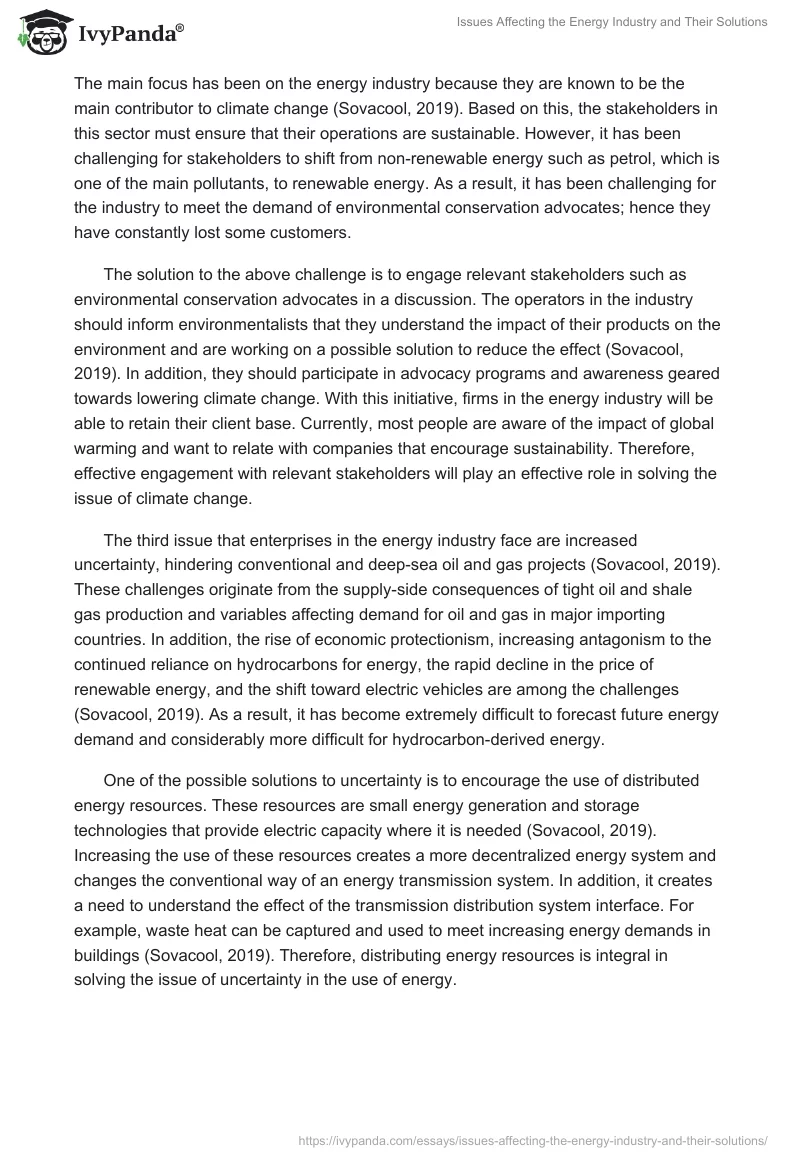The energy industry is among the sectors that are performing effectively. However, it is not immune to challenges that threaten its existence. The increasing demand for sustainable energy is one of the issues affecting the sector (Sovacool, 2019). In addition, consumers in the market are creating pressure on the industry to adopt environmentally friendly energy sources. Apart from this, the energy sector is facing the issue of price volatility. The prices of energy products constantly change, which affects their performance. Although there exist issues that affect the energy industry’s performance, there are solutions that they can use to solve the problems.
Price volatility is one of the most significant concerns in the energy industry. Because of price fluctuations, forecasting oil prices has been a big concern in this industry (Sovacool, 2019). Over the last five years, the situation has deteriorated even further. The fluctuation is caused by several factors influencing supply and demand. On the supply side, the sector has transitioned from models that rely on large-scale developments to short-term investments. On the side of demand, aspects such as the deceleration of economic growth in emerging economies and the gradual substitution of oil. Another demand factor is the increase in more effective and economically friendly buildings and public transportation.
A solution to the above challenge is to promote well-regulated but broadened hedging through financial markets. The demand for oil-consuming and producing corporations to transfer price risk to those willing to bear it will increase (Sovacool, 2019). Based on this, it is important to implement reasonable changes and enforce laws against manipulation and fraud. However, do not impose blanket limitations on financial market players on the incorrect belief that they are the source of the volatility. Instead, the prices should be harmonized by ensuring that all the stakeholders are protected in the market. As a result, effective regulation plays an integral role in controlling price volatility in the energy industry.
The second problem experienced in the industry is the growing efforts to address climate change. There is increasing pressure on the need to reduce global warming. The main focus has been on the energy industry because they are known to be the main contributor to climate change (Sovacool, 2019). Based on this, the stakeholders in this sector must ensure that their operations are sustainable. However, it has been challenging for stakeholders to shift from non-renewable energy such as petrol, which is one of the main pollutants, to renewable energy. As a result, it has been challenging for the industry to meet the demand of environmental conservation advocates; hence they have constantly lost some customers.
The solution to the above challenge is to engage relevant stakeholders such as environmental conservation advocates in a discussion. The operators in the industry should inform environmentalists that they understand the impact of their products on the environment and are working on a possible solution to reduce the effect (Sovacool, 2019). In addition, they should participate in advocacy programs and awareness geared towards lowering climate change. With this initiative, firms in the energy industry will be able to retain their client base. Currently, most people are aware of the impact of global warming and want to relate with companies that encourage sustainability. Therefore, effective engagement with relevant stakeholders will play an effective role in solving the issue of climate change.
The third issue that enterprises in the energy industry face are increased uncertainty, hindering conventional and deep-sea oil and gas projects (Sovacool, 2019). These challenges originate from the supply-side consequences of tight oil and shale gas production and variables affecting demand for oil and gas in major importing countries. In addition, the rise of economic protectionism, increasing antagonism to the continued reliance on hydrocarbons for energy, the rapid decline in the price of renewable energy, and the shift toward electric vehicles are among the challenges (Sovacool, 2019). As a result, it has become extremely difficult to forecast future energy demand and considerably more difficult for hydrocarbon-derived energy.
One of the possible solutions to uncertainty is to encourage the use of distributed energy resources. These resources are small energy generation and storage technologies that provide electric capacity where it is needed (Sovacool, 2019). Increasing the use of these resources creates a more decentralized energy system and changes the conventional way of an energy transmission system. In addition, it creates a need to understand the effect of the transmission distribution system interface. For example, waste heat can be captured and used to meet increasing energy demands in buildings (Sovacool, 2019). Therefore, distributing energy resources is integral in solving the issue of uncertainty in the use of energy.
References
Irawan, G. P., & Manda, G. S. (2021). Pengaruh debt to equity ratio, current ratio Dan quick ratio Terhadap return on assets. COSTING: Journal of Economic, Business and Accounting, 5(1), 81-89.
Sovacool, B. K. (2019). Energy security: challenges and needs. Advances in Energy Systems: The Large‐scale Renewable Energy Integration Challenge, 111-118. Web.
The United States Securities and Exchange Commission (2020). Chevron’s annual financial report. Web.


